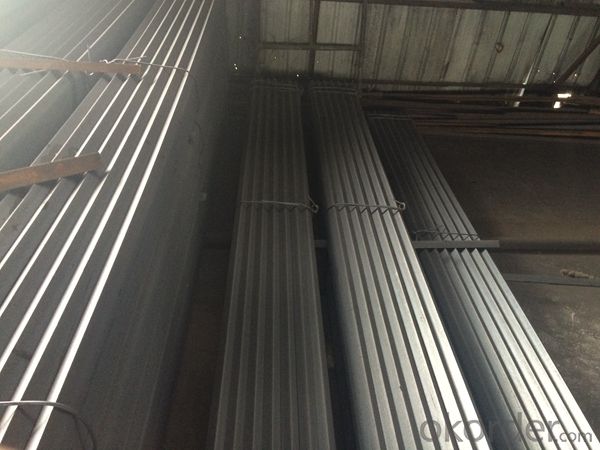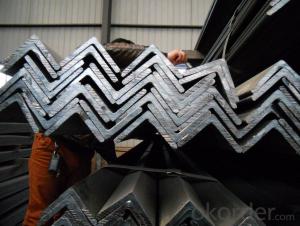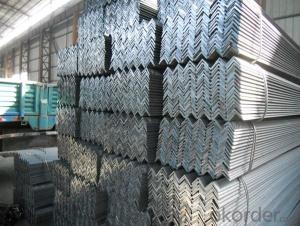Hot Rolled EN Standard Equal Angle Steel Bars for Construction, Structure
- Loading Port:
- Tianjin
- Payment Terms:
- TT OR LC
- Min Order Qty:
- 25 m.t.
- Supply Capability:
- 200000 m.t./month
OKorder Service Pledge
OKorder Financial Service
You Might Also Like
Product Description:
OKorder is offering Hot Rolled EN Standard Equal Angle Steel Bars for Construction, Structure at great prices with worldwide shipping. Our supplier is a world-class manufacturer of steel, with our products utilized the world over. OKorder annually supplies products to European, North American and Asian markets. We provide quotations within 24 hours of receiving an inquiry and guarantee competitive prices.
Product Applications:
Hot Rolled EN Standard Equal Angle Steel Bars for Construction, Structure are ideal for structural applications and are widely used in the construction of buildings and bridges, and the manufacturing, petrochemical, and transportation industries.
1. Supporting members, most commonly in the house raising industry to strengthen timber bears under houses. Transmission line towers, etc
2. Prefabricated structure
3. Medium scale bridges
4. It is widely used in various building structures and engineering structures such as roof beams, bridges, transmission towers, hoisting machinery and transport machinery, ships, industrial furnaces, reaction tower, container frame and warehouse etc.
Product Advantages:
Hot Rolled EN Standard Equal Angle Steel Bars for Construction, Structure are durable, strong, and resist corrosion.
Main Product Features:
· Premium quality
· Prompt delivery & seaworthy packing (30 days after receiving deposit)
· Corrosion resistance
· Can be recycled and reused
· Mill test certification
· Professional Service
· Competitive pricing
Product Specifications:
1.Standards:GB,ASTM,BS,AISI,DIN,JIS
2.Length:6m,9m,12m
3.Material:GBQ235B,Q345BorEquivalent;ASTMA36;EN10025,S235JR,S355JR;JISG3192,SS400;SS540.
4. Sizes

Sizes: 25mm-250mm | ||
a*t | ||
25*2.5-4.0 | 70*6.0-9.0 | 130*9.0-15 |
30*2.5-6.6 | 75*6.0-9.0 | 140*10-14 |
36*3.0-5.0 | 80*5.0-10 | 150*10-20 |
38*2.3-6.0 | 90*7.0-10 | 160*10-16 |
40*3.0-5.0 | 100*6.0-12 | 175*12-15 |
45*4.0-6.0 | 110*8.0-10 | 180*12-18 |
50*4.0-6.0 | 120*6.0-15 | 200*14-25 |
60*4.0-8.0 | 125*8.0-14 | 250*25 |
5. Payment terms:
1).100% irrevocable L/C at sight.
2).30% T/T prepaid and the balance against the copy of B/L.
3).30% T/T prepaid and the balance against L/C
6.Material details:
Alloy No | Grade | Element (%) | |||||
C | Mn | S | P | Si | |||
Q235 | B | 0.12—0.20 | 0.3—0.7 | ≤0.045 | ≤0.045 | ≤0.3 | |
Alloy No | Grade | Yielding strength point( Mpa) | |||||
Thickness (mm) | |||||||
≤16 | >16--40 | >40--60 | >60--100 | ||||
≥ | |||||||
Q235 | B | 235 | 225 | 215 | 205 | ||
Alloy No | Grade | Tensile strength (Mpa) | Elongation after fracture (%) | ||||
Thickness (mm) | |||||||
≤16 | >16--40 | >40--60 | >60--100 | ||||
≥ | |||||||
Q235 | B | 375--500 | 26 | 25 | 24 | 23 | |
FAQ:
Q1: Why buy Materials & Equipment from OKorder.com?
A1: All products offered byOKorder.com are carefully selected from China's most reliable manufacturing enterprises. Through its ISO certifications, OKorder.com adheres to the highest standards and a commitment to supply chain safety and customer satisfaction.
Q2: How do we guarantee the quality of our products?
A2: We have established an advanced quality management system which conducts strict quality tests at every step, from raw materials to the final product. At the same time, we provide extensive follow-up service assurances as required.
Q3: How soon can we receive the product after purchase?
A3: Within three days of placing an order, we will begin production. The specific shipping date is dependent upon international and government factors, but is typically 7 to 10 workdays.
Q4: What makes stainless steel stainless?
A4: Stainless steel must contain at least 10.5 % chromium. It is this element that reacts with the oxygen in the air to form a complex chrome-oxide surface layer that is invisible but strong enough to prevent further oxygen from "staining" (rusting) the surface. Higher levels of chromium and the addition of other alloying elements such as nickel and molybdenum enhance this surface layer and improve the corrosion resistance of the stainless material.
Q5: Can stainless steel rust?
A5: Stainless does not "rust" as you think of regular steel rusting with a red oxide on the surface that flakes off. If you see red rust it is probably due to some iron particles that have contaminated the surface of the stainless steel and it is these iron particles that are rusting. Look at the source of the rusting and see if you can remove it from the surface.


- Q:What is the maximum allowable tensile stress for a steel angle?
- The maximum allowable tensile stress for a steel angle depends on the specific grade and type of steel being used, as well as any relevant industry standards or regulations that may apply. Therefore, it is not possible to provide a specific answer without further information.
- Q:Can steel angles be used for bracing?
- Yes, steel angles can be used for bracing. Steel angles are commonly used in construction and engineering projects to provide structural support and reinforcement. They are versatile and can be easily welded or bolted into place, making them suitable for various applications, including bracing. Steel angles are typically strong and rigid, which makes them effective in providing stability and resisting lateral forces. They are often used to brace columns, beams, and other structural elements, enhancing the overall strength and stability of the structure.
- Q:Can steel angles be drilled or cut?
- Indeed, it is possible to drill or cut steel angles. Steel angles, being a flexible structural material, find extensive use in diverse construction and manufacturing endeavors. It is effortless to drill them for the purpose of creating holes for bolts, screws, or other fastening elements. Moreover, steel angles can be fashioned into specific lengths or shapes by employing tools like saws, plasma cutters, or shears. The capacity to drill or cut steel angles renders them exceedingly adaptable and fitting for an extensive array of applications.
- Q:What are the typical lifespan and durability of steel angles?
- The lifespan and durability of steel angles can differ based on a range of factors, including the quality of the steel, the environment they are used in, and the level of maintenance they receive. However, steel angles are renowned for their exceptional durability and extensive lifespan. Generally, steel angles are engineered to bear heavy loads and provide structural support in various construction and industrial settings. They are typically crafted from either carbon steel or stainless steel, both of which are recognized for their strength and resistance to corrosion. With proper maintenance and protection against corrosion, steel angles can remain in good condition for many decades without significant deterioration. Regular maintenance practices such as cleaning, painting, and applying protective coatings can further extend their lifespan. The durability of steel angles is also influenced by the installation environment. In harsh environments with high levels of moisture, extreme temperatures, or exposure to chemicals, the lifespan may be shorter. However, implementing effective corrosion protection measures can mitigate these effects and ensure a longer lifespan. It is important to note that steel angles used in marine or offshore applications may have a shorter lifespan compared to those used in less corrosive environments. This is primarily due to continuous exposure to saltwater and severe weather conditions, which can expedite corrosion. To summarize, steel angles are renowned for their durability and can have a long lifespan if adequately maintained and protected against corrosion. However, the specific lifespan may vary depending on factors such as the steel quality, environmental conditions, and maintenance practices.
- Q:How do you calculate the shear capacity of a steel angle?
- To calculate the shear capacity of a steel angle, you need to consider the following factors: 1. Material properties: Determine the yield strength of the steel angle. This value represents the maximum stress the material can withstand before it starts to deform permanently. 2. Cross-sectional area: Measure the cross-sectional area of the steel angle. This involves calculating the width and thickness of the angle and multiplying them together. 3. Shear stress: Calculate the shear stress applied to the angle by dividing the applied force by the cross-sectional area. 4. Shear capacity: Compare the calculated shear stress to the yield strength of the steel angle. If the shear stress is lower than the yield strength, the angle is safe and can withstand the applied force. However, if the shear stress exceeds the yield strength, the angle may fail and deform. It is important to note that different design codes and standards may have specific equations or factors to consider when calculating the shear capacity of a steel angle. Consulting the relevant design code or seeking assistance from a structural engineer is recommended to ensure accurate and safe calculations.
- Q:What are the different types of steel angle connections used in seismic design?
- In seismic design, there are several types of steel angle connections commonly used. These connections are specifically designed to withstand the forces and movements experienced during seismic events. Some of the different types of steel angle connections used in seismic design include: 1. Bolted Flange Plate Connection: This type of connection involves bolting a steel plate to the flanges of two angle sections. It provides good resistance against lateral and vertical forces and can accommodate rotational movements. 2. Welded Flange Plate Connection: Similar to the bolted flange plate connection, this connection involves welding a steel plate to the flanges of two angle sections. It offers high strength and stiffness, but it is less ductile compared to the bolted version. 3. Extended Single Plate Connection: This connection is created by extending a single plate beyond the flanges of two angle sections and then welding it to both the flanges. It provides good resistance against lateral and vertical forces and can accommodate some degree of rotation. 4. Double Angle Connection: In this connection, two angle sections are connected together using bolts or welds. It offers high strength and stiffness and can resist lateral and vertical forces effectively. 5. Diagonal Brace Connection: This type of connection involves connecting diagonal braces to the flanges of two angle sections. It provides enhanced resistance against lateral forces and can effectively control building sway during seismic events. 6. Gusset Plate Connection: This connection involves using a gusset plate to connect two or more angle sections together. It provides good strength and stiffness and can resist lateral and vertical forces effectively. Each of these steel angle connections has its own advantages and disadvantages, and the choice of which connection to use depends on factors such as the structural design requirements, loadings, and the level of seismic activity in the region. It is important to carefully consider these factors and consult with structural engineers to ensure the appropriate connection type is used for a seismic design project.
- Q:Can steel angles be used in the construction of warehouses?
- Yes, steel angles can be used in the construction of warehouses. Steel angles are commonly used as structural components in various construction projects, including warehouses. They provide strength and stability to the structure, making them suitable for supporting heavy loads and withstanding the demands of warehouse operations. Additionally, steel angles can be easily fabricated, installed, and connected, making them a cost-effective and efficient choice for warehouse construction.
- Q:What is the lifespan of steel angles?
- The lifespan of steel angles can vary depending on a range of factors including the quality of the steel, the environment in which they are used, and the level of maintenance they receive. Generally speaking, steel angles are known for their durability and longevity, making them a popular choice in construction and structural applications. High-quality steel angles that are properly manufactured and maintained can last for several decades or even longer. However, factors such as exposure to harsh weather conditions, corrosive environments, and lack of maintenance can significantly reduce their lifespan. To maximize the lifespan of steel angles, it is important to choose the appropriate grade of steel for the specific application, ensure proper installation, and regularly inspect and maintain them. This may include measures such as periodically painting or coating the angles to protect them from corrosion, conducting routine inspections to identify any signs of wear or damage, and promptly addressing any issues that arise. In summary, the lifespan of steel angles can vary but with proper care and maintenance, they can last for many years, providing strength and stability to various structures and applications.
- Q:What are the different surface finishes available for galvanized steel angles?
- Some of the different surface finishes available for galvanized steel angles include hot-dip galvanized, electro-galvanized, painted, and powder-coated finishes.
- Q:Can steel angles be used in playground equipment?
- Yes, steel angles can be used in playground equipment. They are often used as structural components to provide stability and support, such as in the frames of slides, climbing structures, or swing sets.
1. Manufacturer Overview |
|
|---|---|
| Location | |
| Year Established | |
| Annual Output Value | |
| Main Markets | |
| Company Certifications | |
2. Manufacturer Certificates |
|
|---|---|
| a) Certification Name | |
| Range | |
| Reference | |
| Validity Period | |
3. Manufacturer Capability |
|
|---|---|
| a)Trade Capacity | |
| Nearest Port | |
| Export Percentage | |
| No.of Employees in Trade Department | |
| Language Spoken: | |
| b)Factory Information | |
| Factory Size: | |
| No. of Production Lines | |
| Contract Manufacturing | |
| Product Price Range | |
Send your message to us
Hot Rolled EN Standard Equal Angle Steel Bars for Construction, Structure
- Loading Port:
- Tianjin
- Payment Terms:
- TT OR LC
- Min Order Qty:
- 25 m.t.
- Supply Capability:
- 200000 m.t./month
OKorder Service Pledge
OKorder Financial Service
Similar products
New products
Hot products
Related keywords


























